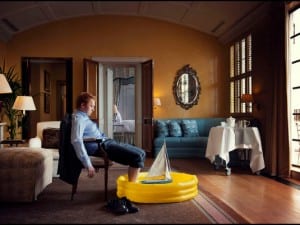The oldest-known cave paintings date back over 40,000 years. They, along with other ancient examples of human creativity, are testament to our species’ desire to make a mark. We have always wanted to tell stories, make sense of the world, and be heard. Street art – as we now know it – emerged in the late-20th century, when young people in New York City started to create images on buildings and subway trains. They used spray cans to make socio-political statements, rebel against established systems and, sometimes, simply revamp their surroundings. Key names from the period include Keith Haring (1958-1990), whose AIDs activism left a legacy far beyond the confines of the art world.

A lot has changed since the 1970s. For one, the information age has transformed our lives. On an average day, we spend more time indoors, looking at screens, than we do outside. This begs the question: what does the future hold for street art? Is it still the most immediate means of grabbing attention? Are we approaching a new frontier? Enter Shepard Fairey (b. 1970), a major figure of the movement who has long blurred the boundaries between traditional and commercial art through type and image. Shepard is founder of OBEY streetwear, and is best known for his iconic 1989 “Andre the Giant Has a Posse” sticker campaign and, notably, the Barack Obama “Hope” Poster (2008). His brand of social critique has spread worldwide via prints, murals, stickers and posters in public spaces.

Street art is, by its nature, an outdoor art form. But it’s not standing still. Trailblazing voices like Shepard are pushing the envelope by unabashedly embracing the possibilities of digital media. For Frieze Los Angeles 2024, he’s teamed up with LG OLED to bring his work into the virtual realm. Titled Peace and Justice, the installation uses LG OLED TVs as a digital canvas whilst drawing attention to some of the most pressing issues facing society today. There’s Swan Song (2023), a reflection on the critical state of the environment, as well as Ideal Power (2017), a digital expression that responds to a pressing need to address gender inequality. The meaning behind Make Art, Not War (2015) is self-explanatory, featuring a female figure surrounded by a floral garland and two paintbrushes. Despite being almost a decade old, the piece feels more timely than ever – especially when viewed in this new digital dimension. “Art is not always meant to be decorative or soothing, in fact, it can create uncomfortable conversations and stimulate uncomfortable emotions,” Shepard explains. “The works included in my collaboration with LG OLED were chosen with these things in mind, and to demonstrate to audiences that the combining of art and technology can drive artistic practice and expression into new and rewarding territory.”

Shepard’s collaboration with LG OLED offers a different viewing experience to that of the street or a gallery. “I believe in reaching people through as many mediums as possible and always playing to the strengths of the chosen medium,” he explains. “Even though I love making physical works on paper, canvas and metal, as well as painting large-scale murals in public spaces, I’m well aware that most people experience art second-hand on screens. I want to maximise the potential of art living on screens, so it’s logical for me to collaborate with LG using some of their most advanced screen technology as a showcase for my work.” It’s an example of how to work with, rather than push against, new media; a way of making art that is rooted in the reality of how we consume content in the 21st century. The clarity, crispness and colour precision of Peace and Justice, made possible by LG OLED’s pixel-level control, brings fresh energy and a new dynamic to already-distinctive pieces. Moreover, the reimagined works are filled with movement – something that is simply not possible to realise using traditional media alone. Shepard has a long-standing interest in cutting and pasting, and these digital collages take it to the next level. Here, layers of colour shift and transform, enhancing powerful messages of protest and acceptance.
The Peace and Justice installation is one of nearly 30 projects spearheaded by the LG OLED ART initiative. Each one celebrates the fusion of art and technology, inviting global collaborators like Anish Kapoor, Damien Hirst, Es Devlin, Hito Steyerl, Refik Anadol and Six N. Five to reinvent their practice.
Shepard Fairey x LG OLED | Santa Monica Airport, Frieze LA
29 February – 3 March
Images: Installation views of Shepard Fairey x LG OLED: Peace and Justice at Frieze LA.





